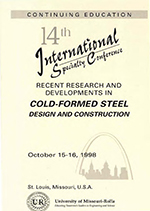Session Dates
15 Oct 1998
Abstract
This paper is the first in a series of articles that report findings of the authors investigation into the behavior of cold formed steel hat sections in bending with multiple intermediate longitudinal stiffeners. Presented in this paper is the test program that was carried out at the University of Waterloo as part of a two year research program. It is known that sections with multiple intermediate stiffeners can fail either in a local sub-element buckling mode, or alternatively, can experience an overall plate buckling mode of failure. Although both failure modes were examined, the main objective was to develop a consistently accurate and practical method of predicting the ultimate bending strength of sections which failed in overall plate buckling. Recent testing carried out by previous researchers indicates that the bending resistance of multiple stiffened cold formed steel members which fail in overall plate buckling is too conservatively predicted by the current Canadian design standard (S136-94). These researchers have also shown that the American design specification (AlSI 96) is unconservative for the same sections. Data from 18 previous test specimens were compiled and supplemented with 94 additional tests carried out at the University of Waterloo, encompassing a range of section dimensions and material properties. All test specimens were simply supported and subjected to uniformly distributed loading. The Waterloo test program consisted of hat sections that failed primarily in overall plate buckling and in a few cases also in local sub-element buckling of the compression flange. Only six of the 112 specimens were observed to have failed in local sub-element buckling, while the remainder experienced overall plate buckling at failure.
Department(s)
Civil, Architectural and Environmental Engineering
Research Center/Lab(s)
Wei-Wen Yu Center for Cold-Formed Steel Structures
Meeting Name
14th International Specialty Conference on Cold-Formed Steel Structures
Publisher
University of Missouri--Rolla
Document Version
Final Version
Rights
© 1998 University of Missouri--Rolla, All rights reserved.
Document Type
Article - Conference proceedings
File Type
text
Language
English
Recommended Citation
Acharya, V. V. and Schuster, R. M., "Bending Tests of Hat Sections with Multiple Longitudinal Stiffeners" (1998). CCFSS Proceedings of International Specialty Conference on Cold-Formed Steel Structures (1971 - 2018). 3.
https://scholarsmine.mst.edu/isccss/14iccfsss/14iccfsss-session2/3
Bending Tests of Hat Sections with Multiple Longitudinal Stiffeners
This paper is the first in a series of articles that report findings of the authors investigation into the behavior of cold formed steel hat sections in bending with multiple intermediate longitudinal stiffeners. Presented in this paper is the test program that was carried out at the University of Waterloo as part of a two year research program. It is known that sections with multiple intermediate stiffeners can fail either in a local sub-element buckling mode, or alternatively, can experience an overall plate buckling mode of failure. Although both failure modes were examined, the main objective was to develop a consistently accurate and practical method of predicting the ultimate bending strength of sections which failed in overall plate buckling. Recent testing carried out by previous researchers indicates that the bending resistance of multiple stiffened cold formed steel members which fail in overall plate buckling is too conservatively predicted by the current Canadian design standard (S136-94). These researchers have also shown that the American design specification (AlSI 96) is unconservative for the same sections. Data from 18 previous test specimens were compiled and supplemented with 94 additional tests carried out at the University of Waterloo, encompassing a range of section dimensions and material properties. All test specimens were simply supported and subjected to uniformly distributed loading. The Waterloo test program consisted of hat sections that failed primarily in overall plate buckling and in a few cases also in local sub-element buckling of the compression flange. Only six of the 112 specimens were observed to have failed in local sub-element buckling, while the remainder experienced overall plate buckling at failure.



